Best Cordless Angle Grinder Head-to-Head
Best 4-1/4″ to 6″ Cordless Angle Grinder Evaluation
Angle grinders are an integral tool for many trades including the steel, automotive, masonry, and landscaping trades. Used for cutting and grinding steel, concrete, stone and masonry, angle grinders require significant power to get the job done. Until recently angle grinders were not considered to be a viable cordless tool. With recent advancements in brushless motors and high capacity batteries most tool manufactures now offer solid cordless angle grinders capable of tasks that previously required a corded tool.
With the addition of accessories angle grinders are an incredibly versatile jobsite tool that can perform a wide variety of tasks including: sanding and polishing wood, cutting drywall and plaster (with minimal dust) and leveling old concrete floors.
For this Head-to-Head the focus is on the more popular smaller 4-1/2″ to 6″ category which is well suited for the cordless platform.
Cordless Angle Grinder Lineup
In order to keep the tools in this Head-to-Head somewhat similar each manufacturer was given a range from 18-22 volts, 4-1/2″ to 6″ diameter, and battery packs ranging from 5.0 to 6.2 Ah. The following cordless angle grinders were included in the test:
- Bosch GWS18V-45 – Bosch 18V EC Brushless Connected 4-1/2 Inch Angle Grinder with No Lock-On Paddle Switch
- DEWALT DCG413 – DEWALT 4-1/2 Inch 20V MAX XR Paddle Switch Small Angle Grinder with Kickback Brake
- Hilti AG 4S-A22 – Hilti AG 4S-A22 4-1/2 Inch 22V Cordless Brushless Angle Grinder with Kwik Lock
- Makita XAG21ZU – Makita 18V Brushless Cordless 4-1/2″ / 5″ Paddle Switch Cut-Off/Angle Grinder with Electric Brake and AWS
- Metabo WPB 18 LTX BL 115 – Metabo 18V 4-1/2 Inch Brushless Cordless Angle Grinder
- Metabo HPT G18DBAL – Metabo HPT 18V Brushless 4-1/2″ Angle Grinder
- Milwaukee 2980 – Milwaukee M18 FUEL 4-1/2″/6″ Braking Grinder with No-Lock Paddle Switch
- Ridgid R86042B – Ridgid Brushless 18V 4-1/2 Inch Angle Grinder
- Ryobi P423 – Ryobi 18V ONE+ Brushless 4-1/2 Inch Cut-Off Tool / Grinder
Cordless Angle Grinder Specifications and Features
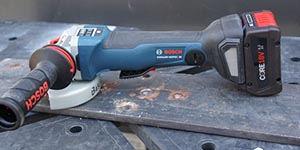 Bosch GWS18V-45
Bosch GWS18V-45
- Disc Diameter: 4-1/2 inches
- Weight: 6 lbs 2 oz
- Voltage: 18V
- Battery Size: 6.3 Ah
- No-load speed: 9000, 6000, 4500 RPM (push button selector)
- Unique illuminated user interface
- LED work light
- Watt-Hours (Voltage x Amp-Hours) = 113.4
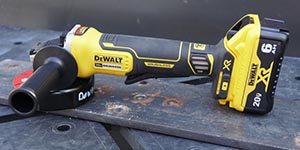 DEWALT DCG413
DEWALT DCG413
- Disc Diameter: 4-1/2 inches
- Weight: 5 lbs 14 oz
- Voltage: 18V (20V MAX No load)
- Battery Size: 6.0 Ah
- No-load speed: 9000 RPM
- Tool-less lock nut
- Kickback Brake
- E-Switch Protection™
- Watt-Hours (Voltage x Amp-Hours) = 108.0
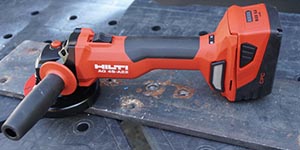 Hilti AG 4S-A22
Hilti AG 4S-A22
- Disc Diameter: 5 inches
- Weight: 6 lbs 4 oz
- Voltage: 22V
- Battery Size: 5.2 Ah
- No-load speed: 3500-8000 RPM (six-step dial)
- Active Torque Control (ATC) stops the tool body from spinning uncontrollably if the disc jams
- Watt-Hours (Voltage x Amp-Hours) = 114.4
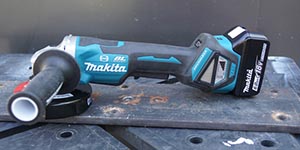 Makita XAG21ZU
Makita XAG21ZU
- Disc Diameter: 4-1/2 or 5 inch
- Weight: 6 lbs 3 oz
- Voltage: 18V
- Battery Size: 6.0 Ah0
- No-load speed: 3500-8500 RPM (variable dial)
- Electric Brake
- Active Feedback-sensing Technology (AFT®)
- Automatic-start Wireless System (AWS™)
- Watt-Hours (Voltage x Amp-Hours) = 108.0
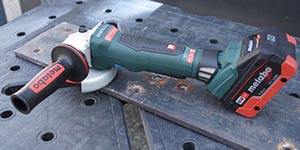 Metabo WPB 18 LTX BL 115
Metabo WPB 18 LTX BL 115
- Disc Diameter: 4-1/2 inches
- Weight: 6 lbs 2 oz
- Voltage: 18V
- Battery Size: 5.5 Ah
- No-load speed: 9000 RPM
- Unique rotating battery
- Tool-free adjustable guard
- Quick braking system
- Electronic safety shutdown of the motor reduces kickback
- Watt-Hours (Voltage x Amp-Hours) = 99.0
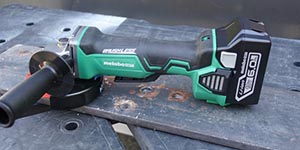 Metabo HPT G18DBAL
Metabo HPT G18DBAL
- Disc Diameter: 4-1/2 inches
- Weight: 5 lbs 11 oz
- Voltage: 18V
- Battery Size: 6.0 Ah
- No-load speed: 9000 RPM
- Kick-back protection
- Auto-mode option automatically adjusts the RPM down when the tool is not in use
- Watt-Hours (Voltage x Amp-Hours) = 108.0
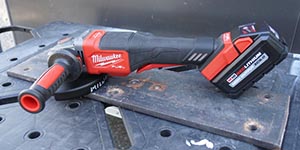 Milwaukee 2980
Milwaukee 2980
- Disc Diameter: 4-1/2 to 6 inch discs
- Weight: 7 lbs 12 oz
- Voltage: 18V
- Battery Size: 6.0 Ah
- No-load speed: 9000 RPM
- Rapid Stop braking feature stops all accessories in 3 seconds or less
- Tool-free accessory changes using the FIXTEC nut and tool-free guard
- Watt-Hours (Voltage x Amp-Hours) = 108.0
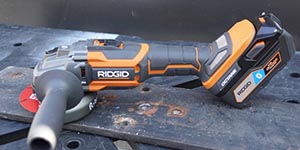 Ridgid R860412
Ridgid R860412
- Disc Diameter: 4-1/2 inches
- Weight: 6 lbs 3 oz
- Voltage: 18V
- Battery Size: 6.0 Ah
- No-load speed: 10,600 RPM
- Tool-Free Guard Design
- Lock-Off Protection
- Watt-Hours (Voltage x Amp-Hours) = 108.0
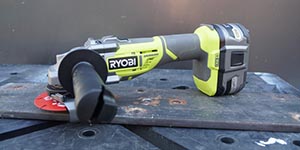 Ryobi P423
Ryobi P423
- Disc Diameter: 4-1/2 inches
- Weight: 6 lbs 1 oz
- Voltage: 18V
- Battery Size: 6.0 Ah
- No-load speed: 10,600 RPM
- Tool-Free Guard Design
- Watt-Hours (Voltage x Amp-Hours) = 108.0
Cordless Angle Grinder Testing & Evaluation
The challenge for any Head-to-Head testing is developing the testing and evaluation criteria in order to create a valuable comparison for users. Obviously there are hundreds of tests that could be performed, however with limited time and resources for this article we chose the following tests as a good baseline comparison.
- Features – an overall comparison of features and specifications.
- Run-Time – each cordless angle grinder was set up in a jig that allows rebar to be cut with a uniform angle and weight. Each grinder cut rebar until the battery was fully depleted, and the results were normalized to account for different size batteries (amp-hours).
- Performance (cutting speed) – again each grinder was set up in the same jig and rebar was cut. Each cut was timed and an average time per cut was calculated from all the cuts.
- Ergonomics – our entire testing crew helped evaluate the ergonomics section by ranking the following categories: grip, side handle, blade guard, blade guard mount, disc change, power switch, battery change, vibration, balance, and maneuverability.
- Price – as usual we’ve compared the pricing for all the grinders at the time of this publication and ranked them accordingly. For this comparison, “bare-tool” pricing was used.
Each category gets ranked and the results from each are then used to determine and overall winner for the Head-to-Head.
Cordless Angle Grinder Testing Criteria
While some of the categories above are subjective, some tests can be measured to give a relative comparison for each tool. As stated earlier, there are literally hundreds of tests that can be done to compare any tool. For this evaluation two tests were selected to give a good relative, measurable comparison including: run-time and performance (speed cutting). While this is an extremely narrow set of tests, we felt it was a good baseline. Clearly run-time is hugely important with high demand cordless tools like grinders, and productivity is always an important benefit to consider when buying any tool so hence the speed of cutting test.
Cordless Angle Grinder Testing Materials
For this evaluation several types of steel and concrete were used in order to get a good perspective on performance. The following materials were included in the testing:
- 5/8” rebar
- 3/8 plate steel
- 1” J-Bolts
- ¼” thick channel stock
- Thin-set mortar applied to concrete block (CMU)
Angle Grinder Features Comparison
Winners – Bosch and Makita
This section of the evaluation considered ten different categories including:
- Tool-less Locking Nut
- LED Light
- Multiple Disc Sizes
- Variable Speed
- Tool-less Guard
- Battery Gauge – On tool gauge for better visibility during use
- Bluetooth Connectivity – Remote Dust Control, Tool Customization, Tool Crib Features
- Electronic Clutch
- Drop Control
- Re-start Protection
This is a straight-up comparison of features, a tool gets a “1” if it has the feature, and a “0” if it does not. The tool with the highest ranking is the best in this category.
Stand Out Features
There are few standout features that affect performance and safety. Not all the grinders had these features, and below we listed these “stand-out features” and the grinders that have them.
- Tool-less Lock Nuts – Only three tools come stock with tool-less lock nuts, the DEWALT, Hilti and Milwaukee. This is a great feature because it saves time. Tool-less lock nuts can be purchased separately for Hilti and Metabo, however they are not standard equipment.
- Variable Speed – The Bosch has an illuminated push-button control that sets 3 speeds, while the Hilti has a 6 step dial, and the Makita grinder has a step-less dial. Variable speed control allows these tools to be used for additional tasks such as grinding stainless steel, or polishing stone and ceramic surfaces.
- Battery Gauges (On the Tool for Better Visibility) – The Bosch and Makita tools have battery gauges both on the tool and on the battery. The Bosch is unique in that its battery life is shown on the bright green illuminated display. These “on-board” gauges really help visually know the remaining battery charge while working without having to stop to check the battery.
- Rotating Battery Pack – A feature unique to the Metabo grinder is a rotating battery pack, that allows the user to get better grinding angles and into tighter spots than might otherwise be possible with a fixed battery.
- Safety Clutch – Many tools come equipped with a safety clutch that shuts the tool down when the wheel binds up during cutting or grinding. The Bosch, DEWALT, Hilti, Makita, Metabo and Metabo HPT all have a safety clutch.
- Drop Control – Another unique feature on the Bosch is “Drop Control” which automatically shuts the tool down when it is dropped.
- Re-Start Protection – All of the grinders except one include some type of re-start protection. This ensures that if a battery runs out of charge, and a new pack is installed while the switch is in the on position that the grinder won’t turn on as the pack is installed. This is a very good safety feature that all grinders should have.
- Remote Dust Control – Makita includes a very nice remote dust control option. Automatic-start Wireless System (AWS™) utilizes Bluetooth® technology for wireless power-on/off communication between tool and dust extractor.
Finishing in a tie for first place were the Bosch and Makita grinders. The Bosch illuminated controls were definitely a favorite of our crew and would give it a slight edge over the Makita if we had to choose. Tied for second was DEWALT, Hilti, and Milwaukee. And in third was a tie between Metabo and Metabo HPT.
Cordless Angle Grinder Testing Stations
In an effort to remove as much human user variability in our test results we look to build testing jigs/rigs that provide repeatable and fair test results. This helps eliminate questions about whether or not a tester is pushing harder or holding a tool at a strange angle which might alter the results. However, with limited time and resources it’s not possible to build a jig for each of our tests. Below is a list of the testing stations for this Head-to-Head. The first station used a jig, while the remaining two stations used the angle grinders free-hand. The two free hand stations were used to give our testers hands on experience for the subjective rankings in ergonomics.
The three testing stations:
- Performance Rebar Cutting Sled: The cutting sled removes the human element with regard to the cutting angle, and pressure. The sled was used for both the run-time calculations and the performance (cutting speed) when cutting 5/8” rebar. The sled was designed to hold each cordless grinder with the cutting disc 90 degrees to the rebar. The sled was designed to roll along a linear cutting motion. The force used during cutting was applied with a 7 lb weight hanging from the sled and transferred with pulleys and cable. Thus each cut was done using the same applied force.
Each grinder used a new Metabo, metal abrasive cut-off disc, and each disc was changed out after 17 cuts.
- Removal of Thin Set from CMU Block– Testers used the cordless angle grinders to remove thin set mortar from CMU blocks with a grinding wheel. A diamond cup grinding disc with dust shrouds, attached to a Bosch HEPA vacuum was used. This station also allowed the testers more “hands on” time with the tools to help with the ergonomics evaluation later in the day.
- Steel Grinding – The crew used the cordless angle grinders to remove surface material from a steel angle. Again this gave the crew increased “hands on” with grinding and polishing for further evaluation. The grinding and cutting station consisted of using the grinders with a variety of discs, including conventional cutting / grinding discs, DEWALT flap discs, Diablo diamond cutting discs and ceramic sanding discs for surface finishing and prep, and beveling steel as though prepping for welding.
Cordless Angle Grinder Run-Time Testing Results
Winner – DEWALT DCG413R2
In this test most of the tools have very similar voltages and battery pack sizes (amp-hours). However, to truly compare them as close as possible, using the total watt-hours (Total available energy) and normalizing the results helps level all of the tools. Watt-hours is simply calculated by multiplying the voltage by the amp-hour rating on the battery pack. In the specification section above we’ve listed the Watt-hours for each tool based on the voltage and pack size. Six of the tested tools have watt-hour ratings of 108, so the other results will be normalized to that. For example, Metabo has a watt-hour rating of 99. So the results for Metabo will be factored up by 108/99 or approximately 9%. Metabo has a 5.5 Ah pack, if it had a 6 Ah pack like the others it would more than likely do about 9% more work.
As you can see above DEWALT had the most cuts per charge with 50, followed closely by Metabo with 49, and Hilti with 47. 50 cuts through 5/8″ rebar with a cordless angle grinder is pretty impressive! Clearly these new generation cordless grinders have the ability to do a serious amount of work per charge and keep up with jobsite demands.
Cordless Angle Grinder Performance (Speed) Testing
Winner – Metabo WPB18LTXBL115
The next test was the performance or speed test. In this test the time to cut 5/8″ rebar was measured throughout the run-time testing and averaged for each tool to calculate the average cut time for 5/8″ rebar. These results provide some insight into not only the cordless angle grinders disc speed, but really the combination of torque and speed which results in the overall time to complete the task.
As you can see below Metabo came in first place followed by Milwaukee and Ryobi. Metabo was nearly twice as fast than the Ridgid.
While measuring run-time and cut speeds, the external temperature of each angle grinder was measured using a thermal imaging tool. For high demand cordless tools like grinders, heat can be a big problem. Below is a chart showing the maximum measured temperature for each tool during the cutting tests. The temperatures were not used in scoring but the information is certainly valuable and worth sharing. As the chart shows, the Metabo ran quite a bit cooler than the other grinders at 92 deg. F, and the Makita topped the chart at 125 deg. F.
Cordless Angle Grinder Ergonomics Evaluation
Winners – Hilti and Makita
For the ergonomics evaluation the team evaluated the following: grip, side handle, blade guard, blade guard mount, disc change, power switch, battery change, vibration, balance, maneuverability, and brake speed. For each category, the team ranked them 1, 2 or 3, (1 being the best). For the brake speed we measured the time for the disc to come to a full stop (shown below in the chart), and ranked them 1 for grinders under 1 second, 2 for grinders that stop between 1 and 2 seconds, and 3 for a brake that took longer than 2 seconds.
Much of the ergonomics evaluation came from team members using the grinders at the thin-set and grinding station. Each team member used each grinder grinding thin-set, grinding steel, and cutting steel to get a relative comparison of each tool.
Each category was totaled up (see table below), and the lowest score being the best. As you can see there was a tie for first place between Hilti and Makita. Second place went to Bosch and Milwaukee finished in third.
Cordless Angle Grinder Pricing Evaluation
Winner – Ryobi
For this Head-to-Head we’re using a different approach with the pricing evaluation. In the past we tried to use kit pricing, and if kit pricing wasn’t available, we’d use bare tool plus battery pack and charger. That seemed to be a bit inconsistent so this time the pricing is based solely on the bare tool. Every manufacturer offers bare tool pricing so this way the battery pack costs are not a factor.
Below is a chart showing the pricing (at the time of publication) of each of the bare tools. There are three distinct groups, around $100 includes Ryobi, Bosch and Ridgid. Just under $200 is DEWALT, Hilti and Metabo HPT, and the three tools over $200 include Makita, Metabo and Milwaukee. As we always do, these will be ranked on just the cost, as cost is a factor for many users when combined with the other results. Finishing in first place is the Ryobi, followed by Bosch and Ridgid in second, and DEWALT in third.
Buy Now From Our Sponsored Retailers
Best Cordless 4-1/2″ to 6″ Angle Grinder Winner
DEWALT DCG413
As usual the Head-to-Head competition was very close but at the end of the Day the Tool Box Buzz Crew must pick a winner and the DEWALT DCG413 is our winner of Best 4-1/2″ to 6″ Cordless Angle Grinder.
The DEWALT DCG413 edged out the competition by one point. It finished first in run-time, tied for second in features, third in price, and fourth in ergonomics and speed. Our team felt it was a well balanced, feature filled grinder with plenty of power and run-time to get the job done.
Finishing in a close second was the Bosch GWS18V-45 finishing first in features, second in ergonomics and price, fifth in speed and sixth in run-time. Third place goes to the new Hilti AG 4S-A22 that just hit the market. It finished first in ergonomics, tied for second in features, third in run-time, fourth in price, and seventh in speed.
Below is a summary table of all the final rankings.
Final Thoughts – Cordless Angle Grinders
Cordless angle grinders are the real deal now! When it comes to smaller size grinders in this category the run-time is sufficient for lots of tasks and when paired with an extra battery most can keep workers in the game all day. The benefits of not dragging around a cord are numerous and the freedom certainly increases productivity and safety.
We get lots of comments about how we make the final rankings. As we’ve stated, there are hundreds of ways to compare tools. The good news is we’ve openly shared ALL the data from our tests, and you can rank the tools however you want. Don’t care about the price? No problem eliminate that from the matrix above and re-rank them. Hopefully you’ll find this Head-To-Head useful in comparing a wide range of small cordless angle grinders.
Best Cordless Angle Grinder – Heat-to-Head Video Review
About the author
6 Comments
Leave a comment
Disclosure
Product reviews on this site contain our opinion of a product or service. We will always strive for objectivity and transparency in our reviews. Our goal is to provide readers with honest, objective information based on our own experiences. We never have and never will accept payment in exchange for a positive review. Many of the products that we review are provided to us for free by a manufacturer or retailer. In some cases, we also have advertising or affiliate relationships with manufacturers and retailers of products and services we review. For additional information please visit our additional disclosure policies.












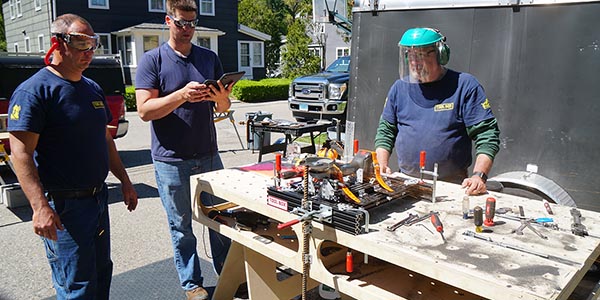

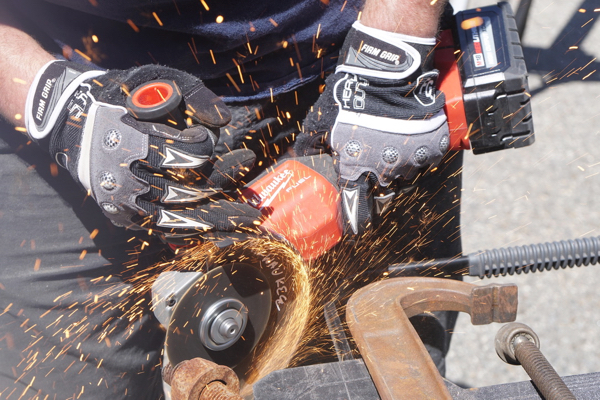

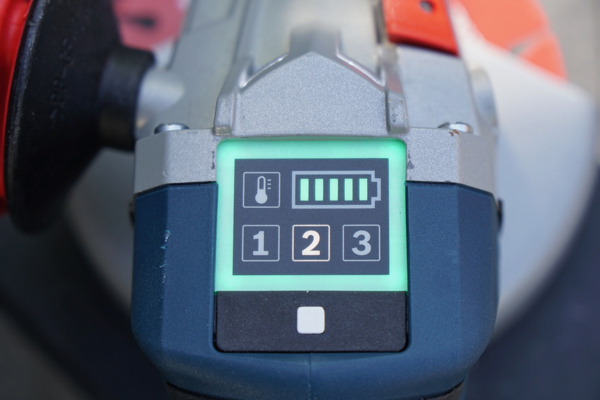
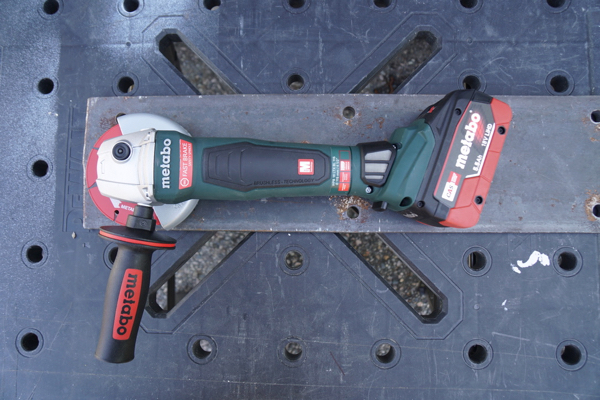
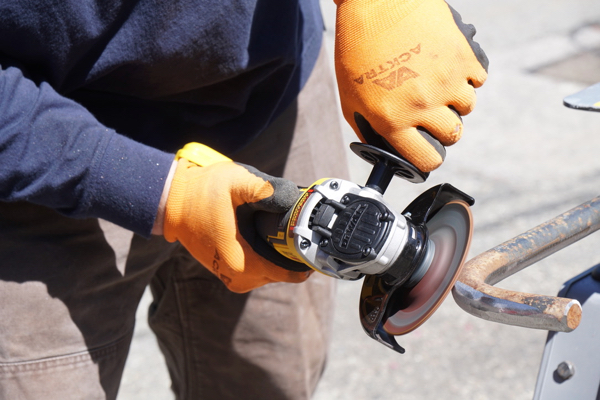
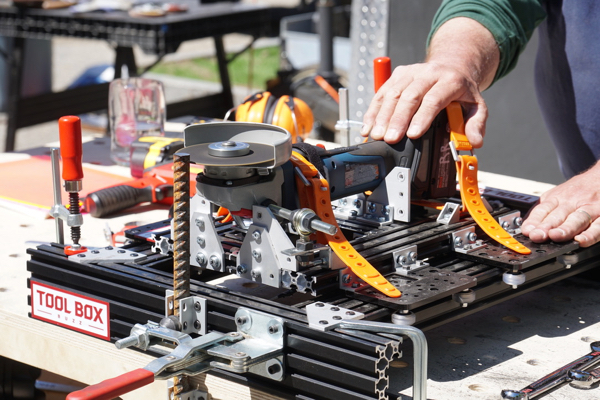
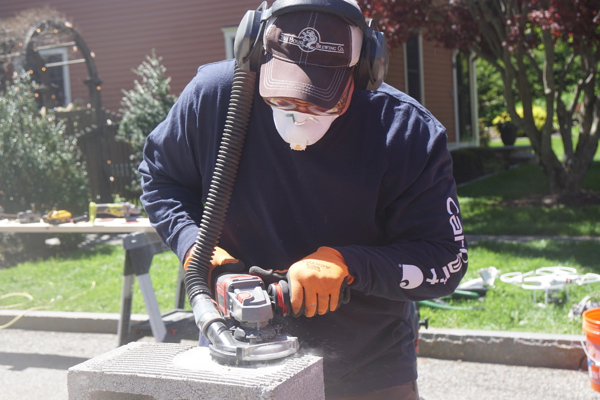
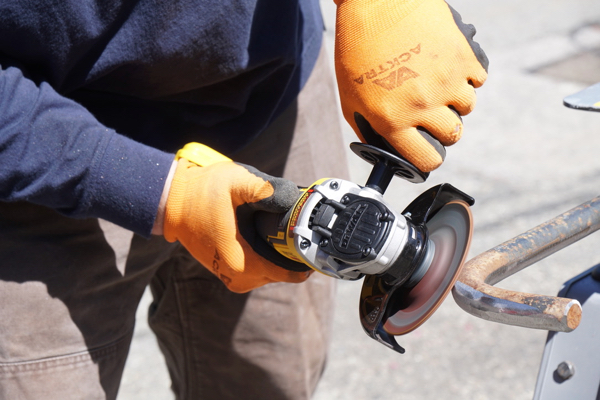
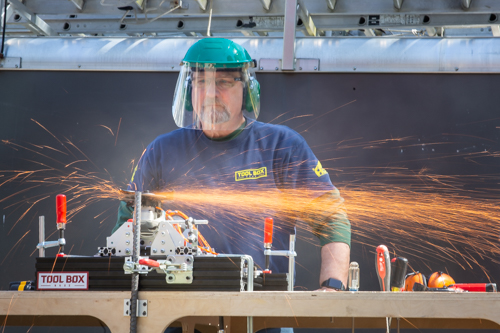
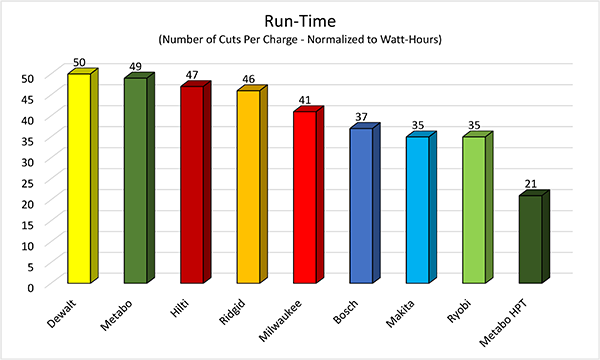
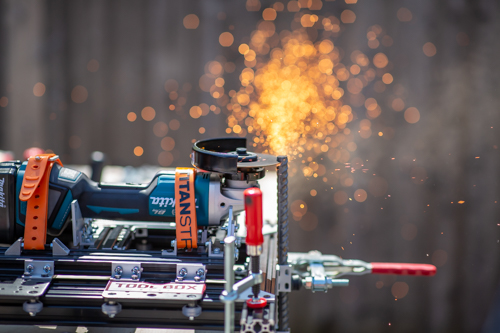
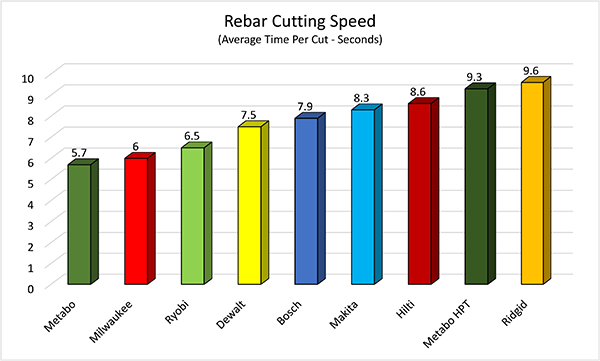
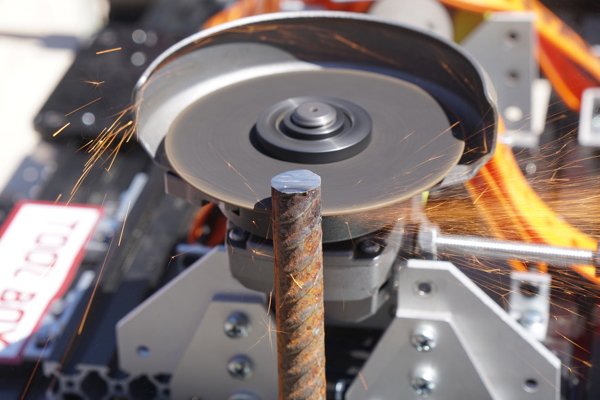
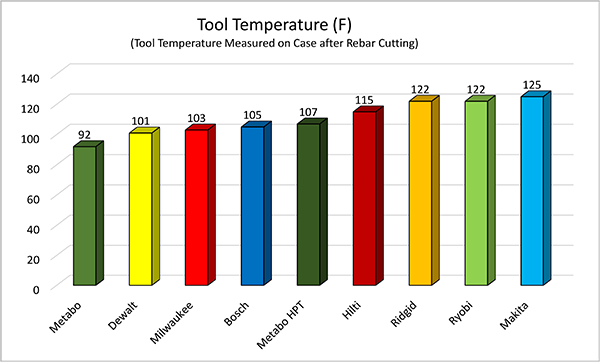
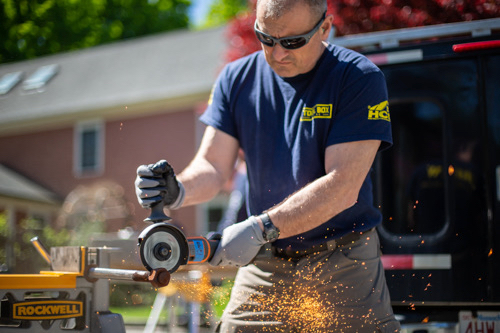
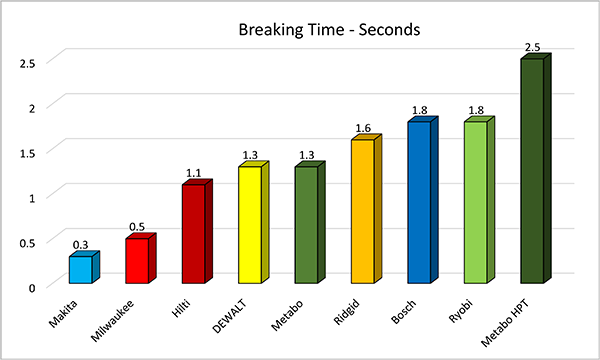
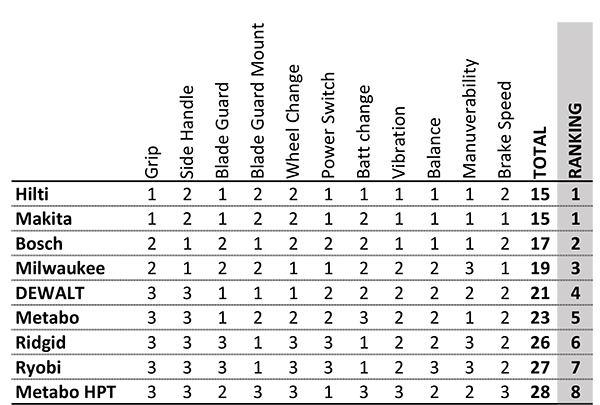
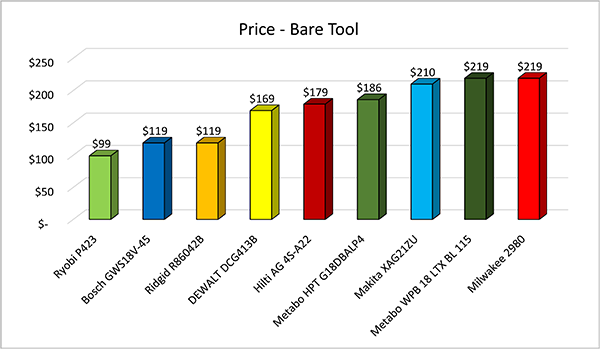
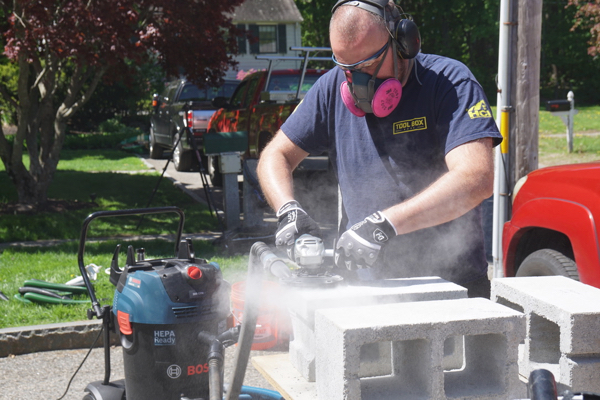
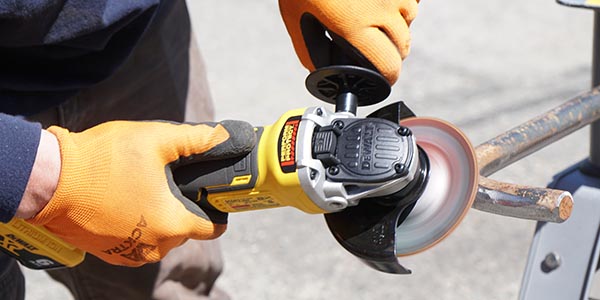

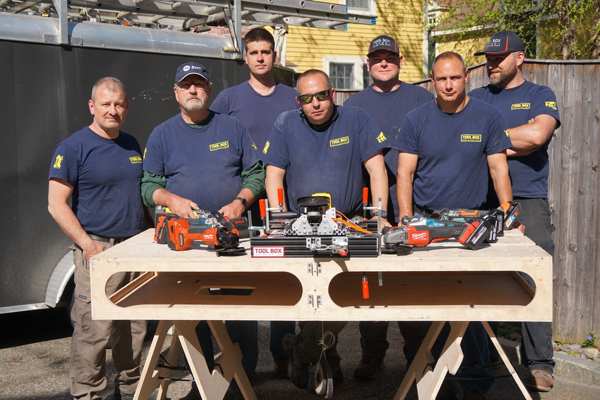

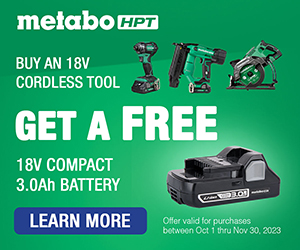










I would like to provide and important clarification that is needed on the tool model number for the Bosch. There are three versions (feature levels) of the tool itself, GWS18V-45C, GWS18V-45PC and GWS18V-45PSC. The model number should not have been shortened in the headings or the “buy now from our sponsored retailer/other ioptions” section, as the 45PSC variation (tested) has features that the other two do not, namely the user interface on the top, and bluetooth module pre-installed. The bluetooth module is optional on the 45C and 45PC.
Likewise, the graphic for the prices should be updated, as the bare tool pricing will also vary between the three. The $119 bare tool price represents the base model GWS18V-45, Ohio Power Tool offers the GWS18V-45PCN for $179, but the GWS18V-45PSC is only available as a kit so far as I have found, typically retailing on average for $300.
True, all three share many parts and share a common instruction book, but to get the Bosch grinder as-tested, it means getting a kit for $300. I know the intent was to price them as bare-tools for apples-to-apples, but it’s not available on the Bosch as-tested.
Yeah, it’s actually really annoying that the laser show model never came as a bare tool.
The 1600 watt equivelant 8 ah battery is the bees knees. I don’t want the older battery nor another charger.
Nor did I need any of that kit when it originally came out (last year?). I wish the major manufacturers would just do away with the kits and price the batteries honestly. Rob, you’ve got to fix these charts because these are three completely different grinders.
Also, as a heads up. The Makita XAG20z is the same model as the XAG21z but without the bluetooth module.
So, for those with dust extractors other than the bluetooth Makita, there’s about a $60-70 savings for you. Makita doesn’t exactly go out of their way to inform people about the differences between 7 or so different price tiered versions of the same product, nor are they consistent about model numbers across continents.
Love to know what you liked or more likely didn’t like about the auxiliary handle on the Milwaukee unit, it looks like it has some feature that I’m unware of or is it just shaped differently?
Are you looking at the anti-vide material?
Excellent review. Thanks so much for this!